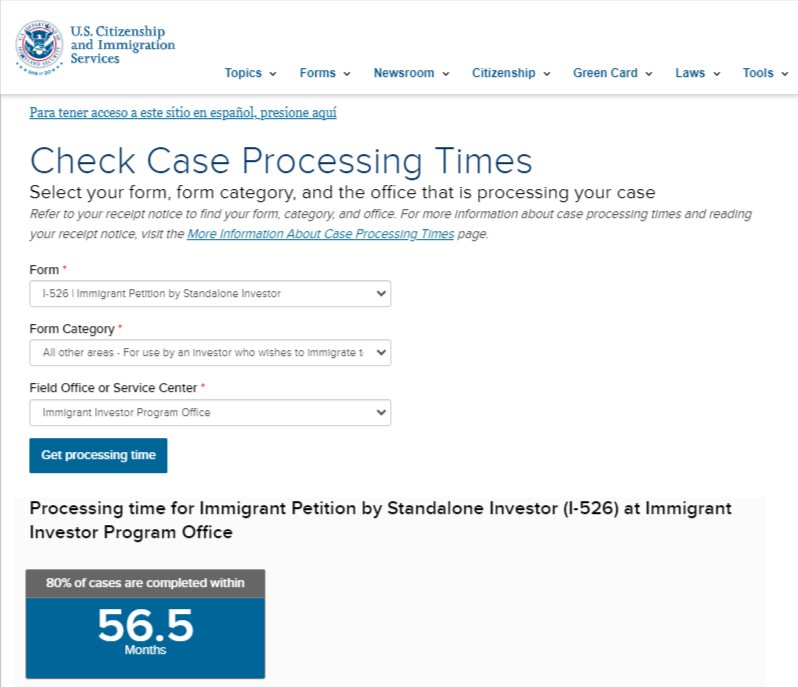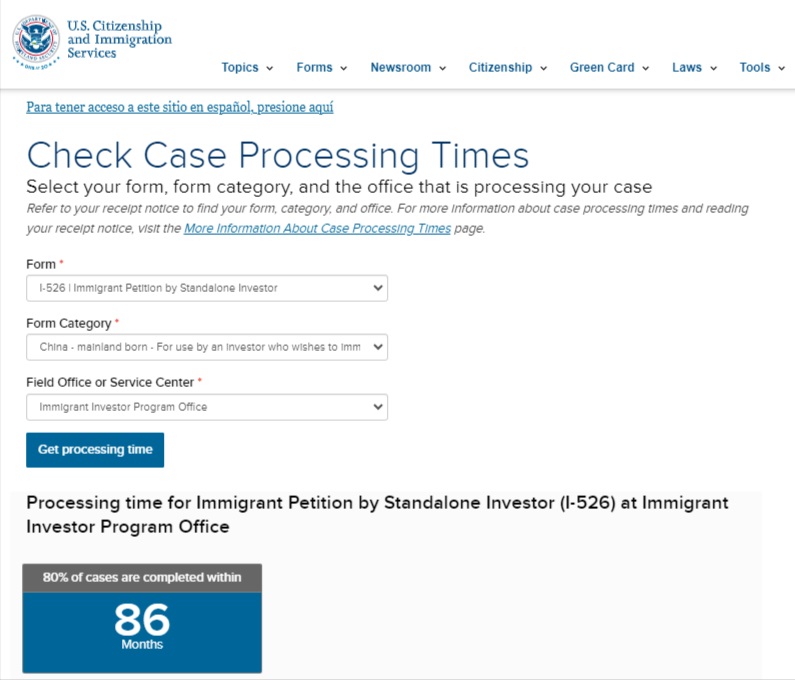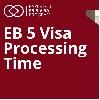I 526E Processing Time | EB-5 Investor Receives I-526E Approval | Navigating the Crucial I-526E Petition: Your Gateway to a U.S. Green Card
Filing Form I-526E is a pivotal step for EB-5 investors seeking a U.S. Green Card through a regional center project. To conquer this challenge and secure your future, mastering the intricacies of the I-526E and gathering the required evidence is essential.last updated Wednesday, December 24, 2025
#i-526e form #i 526 processing time
| | by Sidra Jabeen | Content Manager, Paperfree Magazine |

QUICK LINKS
AD
Get Access to EB 5 Investment Visa Resources
Key Takeaway:
- Form I-526E is the key application for EB-5 investors in regional center projects.
- It requires proof of investment, lawful source of funds, and a job creation plan.
- Minimum investment amounts are $800,000 (TEA) and $1,050,000 (non-TEA).
- Direct investments need W-2 jobs; regional centers can use indirect/induced jobs (subject to RIA limits).
- USCIS processing times for I-526E vary and change regularly; rural set-aside filings receive priority processing under the RIA.
- Amendments and “good-faith investor” protections may be available if a regional center or NCE is terminated or debarred.
- I-526E is specifically for regional center projects; I-526 is for direct investments.
- Consulting an immigration attorney is highly recommended for I-526E filing.
Petition I-526E or I-526: The First Step Toward An EB-5 Green Card
Securing approval for Form I-526E necessitates thorough research, selecting a USCIS-compliant EB-5 offering, and submitting comprehensive evidence. This pivotal step marks the initial move for foreign nationals aspiring to attain U.S. permanent resident status.
For those considering immigration through the EB-5 visa, contacting paperfree is recommended for top-notch guidance in identifying a secure offering and initiating the I-526E petition.
Steps To Take Before Submitting the I-526E Petition | I-526E approval process for EB-5 investor
The core of the EB-5 Immigrant Investor Program is granting Green Cards to foreign nationals who make eligible investments in U.S. businesses, known as new commercial enterprises (NCEs), with a requirement to generate a minimum of 10 jobs per investor.
Before submitting Form I 526E, individuals must have already invested in an NCE. An NCE is described as a for-profit enterprise established after November 29, 1990, and businesses across various industries can qualify for EB-5 funding.
i-526E Form | Navigating the Crucial I-526 E-Petition
Filing i-526e form is a pivotal step for EB-5 investors seeking a U.S. Green Card through a regional center project. This document showcases your qualifying investment and unlocks your path to a conditional two-year residency. To conquer this challenge and secure your future, mastering the intricacies of the I-526E approval process for EB-5 investors and gathering the required evidence is essential.
This guide sheds the light on each section of the petition, empowering you to:
- Demonstrate a compliant investment
Prove your capital injection into the NCE (New Commercial Enterprise) and source it lawfully. - Highlight job creation potential
Showcase the NCE's business plan and ability to generate 10 jobs. - Navigate regional center complexities
Understand how job creation is calculated differently compared to direct EB-5 investments. - Gather accurate evidence
Identify the documents needed to prove your investment, lawful source of funds, and potential for job creation.
With this knowledge in hand, you can take informed steps toward obtaining your U.S. residency:
- Seek expert guidance
Collaborate with an experienced immigration attorney to navigate the nuances of the I-526E petition. - Prepare meticulously
Compile all necessary evidence, ensuring documentation meets USCIS's rigorous standards. - Stay informed
Be aware of potential processing times and any future changes to the EB-5 program.
Remember, your journey towards a U.S. Green Card begins with mastering the I-526E petition. This guide is your compass, helping you confidently navigate the process and pave the way for a brighter future.
How to Prepare Form I-526E
The three primary purposes of the I-526E petition are to prove that:
- A qualifying EB-5 investment was made in an NCE.
- The investment was made using lawfully sourced funds.
- The NCE has a credible business plan and employment creation projections.
We now examine how investors can submit the appropriate evidence in Form I-526E. This application is typically prepared with an immigration attorney’s assistance.
| Evidence Needed | Notes |
| 1. Qualifying EB-5 Investment |
|
| Bank statements | Clearly show investment amount in NCE. |
| Loan certificates | Demonstrate funding source if applicable. |
| Promissory notes | Proof of future investment commitments. |
| Escrow account records | Track funds securely until petition approval. |
| TEA data (rural or unemployment) | Reduced investment amount requires proof of TEA designation. |
| Census data | Verifies rural TEA status. |
| ACS/LAUS data | Supports unemployment data for TEA qualification. |
| 2. Lawful Source of Funds | |
| Salary payment records | Income source documentation. |
| Real estate sales documents | Proof of asset sale proceeds. |
| Secured loan agreements | Demonstrate borrowing details. |
| Stock sale records | Track capital gains from sales. |
| Inheritance documentation | Verify inheritance as a legitimate source. |
| Attorney Guidance | Crucial for navigating USCIS standards. |
| 3. Credible Business Plan & Job Creation | |
| NCE business plan | Detailed operational plan, financial projections, and hiring timetable. |
| Management team background information | Demonstrate their qualifications and experience. |
| Job position descriptions | Provide specifics for each projected position. |
| Direct investment: Full-time W-2 payroll records | Proof of job creation within the company. |
| Regional center investment: Economic impact data | Demonstrate indirect and induced job creation (subject to statutory caps). |
| Attorney assistance | Ensure compliance with job creation calculations. |
Support notes:
- Proof of Investment in an NCE
Evidence of an investment may include the NCE’s bank statements, loan certificates, promissory notes, or escrow account records (EB-5 capital is often stored in an escrow account until the investor's I-526E petition is approved). - Evidence of TEA designation
If the NCE is located in a TEA and qualifies for the reduced investment amount, evidence of TEA designation must be submitted along with Form I-526E.
Data supporting rural TEA status can be obtained from the most recent 10-year national census and the U.S. Office of Management and Budget. Unemployment data can be obtained from the American Community Survey (ACS) and Local Area Unemployment Statistics (LAUS). - Lawful Source of Funds
Proving the lawful sourcing of the EB-5 investment constitutes a significant challenge in preparing the I-526E petition. USCIS maintains stringent standards for source-of-funds documentation, necessitating investors to trace their capital flow meticulously.
This thorough process enables USCIS to screen out applicants with questionable backgrounds.
Given the diverse nature of investors' funding sources, including salary payments, real estate sales, secured loans, stock proceeds, or gifted capital, USCIS accepts virtually any legal source. The guidance of an immigration attorney is crucial for determining the specific documentation required in each case. - Potential for Job Creation
Form I-526E must demonstrate that the invested capital will create a minimum of 10 qualifying jobs within two years of the investor commencing conditional residency.
For this purpose, the business plan of the NCE should encompass details such as the business's purpose, operational plan, financial projections, and background information on the management team. USCIS places greater credibility on business plans that describe each projected job position, including a hiring timetable. - Investors must know of substantial differences in job creation calculations between direct and regional center-sponsored EB-5 offerings. The direct investment model mandates NCEs to establish full-time, W-2 positions reflected on the company's payroll, sustained for at least two years, and filled by workers authorized for U.S. employment.
- In contrast, NCEs in the regional center program can consider indirect and induced employment. Under the RIA, no more than 90% of total jobs may be indirect, and where construction activity lasts fewer than two years, no more than 75% of total jobs may be based on that construction activity. Projects must include sufficient direct jobs to meet the 10-job requirement.
- The Investor’s Managerial Role
The EB-5 program isn't just about investing but actively contributing to your chosen NCE's (New Commercial Enterprise) success. However, your involvement in the day-to-day operations depends on the company's unique management structure. And guess what? This crucial information needs to be woven into your I-526E petition.
Think of it as showcasing your role in the NCE's engine. Whether you're steering the wheel as a board member or guiding the gears as a limited partner, clearly detailing your level of involvement in the petition builds trust and demonstrates your commitment to the program's goals.
So, how do you unveil your role like a pro? Here are some tips:- Identify the structure: Understand the NCE's specific management framework, whether it's a limited partnership, board-driven system, or something else entirely.
- Define your position: Pinpoint your designated role within that structure. Are you a voting member, advisor, or investor with limited say?
- Document your involvement: Gather evidence of your participation, like meeting minutes, voting records, or communication logs with NCE leadership.
Remember, transparency is critical. By accurately reflecting your involvement in the I-526E petition, you open the door to a smoother immigration process and set the stage for a rewarding, collaborative journey with your chosen NCE.
- Information on the Regional Center
Form I-526E must also include information on the regional center sponsoring the NCE. Before accepting I-526E filings for a project, regional centers must submit a “project request” I-956F form and provide the receipt number to investors. Each investor’s I-526E petition must include the receipt number for the project’s I-956F form. All administrative costs and fees the investor pays must also be reported. - The Investor’s Background Information
Investors must include background information on Form I-526E, including their employment history, net worth, and past compliance with U.S. work authorization and immigration laws.
Form I-526E Amendments
Sometimes, an EB-5 investor’s NCE or regional center may be terminated or debarred for noncompliance. Under current USCIS policy, certain “good-faith investors” may retain eligibility despite such actions, including by notifying USCIS they still meet requirements or amending their petition (for example, re-associating to a compliant regional center or project) where necessary.
Submitting the I-526E Petition
An investor’s immigration attorney typically submits Form I-526E to USCIS. As of today, the I-526E filing fee is $11,160. For initial I-526E filings, a separate $1,000 EB-5 Integrity Fund fee is also required. USCIS requires separate fee payments for Form I-526 or I-526E if filed together with Forms I-485, I-131, or I-765. Upon adjudication, USCIS may either approve the I-526E petition, deny the form, or send a request for evidence. The agency's decision should be favorable if the applicant shows that the funds were sourced legally and provides sufficient evidence of compliance with USCIS standards.
Processing Times for Form I-526E
USCIS now posts current estimates for Form I-526E on its processing times page. Timeframes are dynamic and may be influenced by visa availability and case type. Petitions filed in the rural set-aside category receive priority processing under the RIA, which can result in comparatively faster adjudications. The following historical table reflects legacy Form I-526 national medians only.
Historical I - 526 Processing Time Statistics (areas outside of China)
| Fiscal Year | Processing Time, months* |
| 2017 | 16.6 |
| 2018 | 17.9 |
| 2019 | 19.0 |
| 2020 | 31.1 |
| 2021 | 32.5 |
| 2022 | 44.2 |
| 2023 | 50.0 |
Table: I - 526 Processing Time
source: https://egov.uscis.gov/processing-times/historic-pt
*The number of months shown is the median.
USCIS uses a visa-availability approach to prioritize assignment of certain EB-5 petitions. Actual timelines depend on case specifics, visa availability, and the petition category (for example, rural set-aside versus unreserved).
USCIS’s current processing time tool provides the latest estimates. Investors from high-demand countries should also monitor the monthly Visa Bulletin for cutoff dates that may affect visa issuance.
Current I 526 processing times
| All other areas | China-mainland born |
 |
 |
Table: Current I - 526 Processing Time
Source: https://egov.uscis.gov/processing-times/
Learn more on subject EB-5 processing time by country, EB5 Processing Time, A Journey Towards Green Card.
Why EB5 I 526 processing time so long?
Several factors impact the processing times for I-526 petitions. These include the complexity of the documentation related to the source of funds, the accuracy of the petition, and the investor's country of origin. For instance, if the source of funds is more complex, it may take longer to verify, and if there are any errors in the petition, it may lead to requests for additional evidence.
How Will the EB-5 Reform and Integrity Act of 2022 Impact I-526E Processing Time?
Program updates affecting I-526E (RIA & 2023–2025 policy)
Under the RIA, USCIS gives priority processing to rural I-526E filings and reserves a share of annual EB-5 visas for rural, high-unemployment, and infrastructure projects. USCIS also clarified the required investment timeframe for post-RIA cases (generally a two-year sustainment period starting when the full amount is placed at risk and made available to the JCE, as appropriate). These measures, along with ongoing staffing and policy updates, shape current adjudication timelines.
Special Instructions and Other Considerations | EB-5 investor I-526E approval
You will receive separate receipt notices for properly filed Form I-526 and Form I-526E. The first notice you should expect to receive will be from the USCIS lockbox, acknowledging receipt of your Form I-526 or Form I-526E and the total fee amount received and processed.
We will then issue a formal receipt notice that includes the assigned receipt number for the application when data entry has been completed.
Form I-526: Important Fee Payment Change
Effective September 1, 2022, separate fee payments are required when filing EB-5 forms together with related applications.
Here's what you need to know:
- Combined Payments No Longer Accepted
Applicants or petitioners cannot combine fee payments for Form I-526 or Form I-526E with Form I-485, Form I-131, or Form I-765. - Separate Payments Required
Petitioners must submit distinct fee payments for Form I-526 or Form I-526E, even if filed concurrently with other forms. - Non-Compliance Consequences
Failure to submit separate payments will result in form rejection and fee return.
Additional Information: i526e filing fee
- Filing Fee for Form I-526 / I-526E
$11,160 (current). Initial I-526E filings must also include a separate $1,000 EB-5 Integrity Fund fee. - Accepted Payment Methods
Money order, personal check, cashier's check, or credit card (using Form G-1450) - Payable to
U.S. Department of Homeland Security - Fees Are Nonrefundable
Filing and biometric service fees are not refundable, regardless of application outcomes. - Use Fee Calculator
Determine your exact fee using the provided calculator.
Electronic Processing Transition:
- Separate payments are required due to the transition to electronic processing, which involves multiple processing systems.
- Combined payments may lead to package rejection.
Ensure compliance with these updated fee payment guidelines to avoid delays and complications in your immigration petition process.
Form Filing Tips
Filing Tips: Review the Tips for Filing Forms by Mail page for information on ensuring we accept your form.
Differences Between the EB-5 Regional Center Program and Direct EB-5 Investment
| Investment in Direct EB-5 Opportunities | Investment in EB5 Regional Center Program |
| Funds Flow | |
| Invested directly into an NCE | Invested in a regional center's funds |
| Job Creation Responsibility | |
| NCE itself is responsible for job creation (JCE) | Regional centers manage funding across multiple NCEs |
| Relationship Between NCE and JCE | |
| NCE and JCE are typically the same entity | NCE and JCE are usually separate entities |
| Form for Petition | Form for Petition |
| Form I-526 is used by investors in direct EB-5 projects | Form I-526E is used by investors in regional center projects |
| Popularity in EB-5 Program | |
| Less popular compared to regional center investments | The most popular investment vehicle in recent years |
| Investment Projects List | |
| EB5 direct investment projects | EB5 investment projects list |
Minimum Investment Amount
| Investment Amount | Targeted Employment Areas (TEAs) | Other Projects |
| Minimum Investment | $800,000 | $1,050,000 |
| TEA Criteria | Rural areas or an unemployment rate of 150% of the U.S. national average | Not subject to specific TEA criteria |
Learn more about EB 5 Investment Amount and Total EB 5 visa Cost
How an EB5 Visa Consultant Can Help?
An EB-5 visa consultant plays a critical role in helping investors navigate the complex EB-5 immigration process, including understanding the current I-526 processing time and developing an appropriate EB-5 timeline. They provide support for investors, especially those interested in the EB-5 processing time for India and the EB-5 visa waiting time for India.
Consultants assist in selecting a New Commercial Enterprise (NCE) that meets the USCIS requirements. This involves ensuring that the investment amount — whether $800,000 for Targeted Employment Areas (TEAs) or $1,050,000 for other projects — is properly allocated to maximize efficiency and minimize the waiting time in the EB-5 timeline for India.
A consultant also helps with preparing Form I-526, using an EB-5 template that includes extensive documentation, such as proof of lawful source of funds, TEA designation, and a well-prepared business plan that demonstrates job creation potential. They understand the eb 5 processing time India and the nuances required to ensure smooth I-526 processing.
Working in collaboration with immigration attorneys, EB-5 consultants assist in tracking and documenting the capital flow and in filing necessary amendments, ensuring compliance with the EB-5 Reform and Integrity Act. Their understanding of current i-526 processing times and eb5 visa timeline for India helps investors have the best chance at securing an EB-5 investor visa in India and ultimately obtaining U.S. permanent residency.
Pages Related to #i-526e form
- EB5 Processing Time: A Journey Towards Green Card 2026 | Paperfree.com

- EB-5 processing time by country updated 2026

- EB-5 Regional Center Audit to Ensure Compliance and Transparency

- EB5 Visa For Indian Investors | Paperfree.com

- Lasting Impact of USCIS Form I-526E Changes on EB-5 Visa Investors

- USCIS Update July 2024: Prevent Application Rejection
- EB-5 Project Approval Process for Regional Center Investments

- EB5 Program Timeline: All You Need to Know

Popular Page
Benefits of the EB-5 Visa Program| A Comprehensive Guide
Book a Free Complimentary Call
real estate investing Investment Visa USA Investment Magazine Private Real Estate Funds real estate funds

